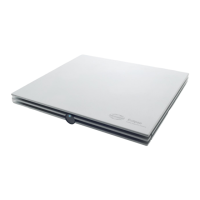Eclipse Additional Information Page 217
11 Dictionary
As this dictionary may be used as a guide, some of the words give rise to more comments than just the basic
definition.
ABR: Auditory Brainstem Response. An AEP, ABR is a recording of the electrical signals generated by the
nerves that are transmitting the sound-elicited signal from the Cochlea through the Brainstem. Five different
points on this route give rise to electrical potentials emanating to a degree that they are strong enough to be
recorded. They appear as wave peaks on the ABR waveform, and may be assigned Waveform Markers I, II,
III, IV and V respectively. These are sometimes referred to as Jewett markers.
ABR15: ABR recorded in a 15ms time window. Well suited for normal ABR.
ABR30: ABR recorded in a 30ms time window. Preferred by some clinics, when threshold testing of neo-
nates using the ABR.
AEP: Auditory Evoked Potentials. ABR is an example of an AEP. Electrical potentials caused by activity in
the nerves system initiated by a sound stimulus. These electrical activities are often recorded at the surface
of the head by means of electrodes and then amplified and finally processed in an evoked potential system
providing a resulting waveform.
Alternating (polarity): The polarity of a sound stimulus indicates which direction the diaphragm of the trans-
ducer moves. This is primarily important for clicks, as a click consists of an activated movement in one direc-
tion only. Alternating Polarity indicates that every other stimulus moves in the other direction, so all the even
numbered stimuli carries one type of stimuli type (e.g. rarefaction), and all the odd numbered stimuli carry the
alternative stimuli type (e.g. condensation).
ALLR: (Also LLR or LL): Auditory Late Latency Response. These are electrical responses picked up with a
time window of up to 1000ms. The resulting waveform can be interpreted for cortical activities related to the
sound stimulus.
AMLR: (Also MLR or ML): Auditory Middle Latency Response. These are responses that can be observed in
a 150ms time window.
Averaging: Calculating the average electrical response from a great number of stimuli. In e.g. ABR this is
done for each point at a time scale of typically 15ms. The result is a waveform that plots the electrical re-
sponse versus time elapsed from stimulus onset. The purpose of averaging is to record an evoked response
(the “signal”) that is usually far smaller than other potentials that are also unavoidably recorded (the “noise”).
Averaging improves the signal to noise ratio, allowing the desired response to be identified and analysed.
Baseline: A horizontal line through the waveform at 0,0µV. This may be helpful in evaluating the response.
Burst: See Tone Burst
Calibration: Two types of calibration are used in the world of ABR – peSPL (peak equivalent SPL) and nHL
(normal HL). peSPL relates to the absolute physical characteristics of the stimulus whereas nHL is used to
describe the stimulus relative to the average normal adult subjective hearing threshold for that stimulus.
Even when the nHL scale is used, two further issues must be considered by the user when using AEP tests
to estimate the patient’s hearing threshold:
1. There is an average different between the true (behavioural) hearing threshold and the electrophysiologi-
cal threshold (e.g. ABR threshold) and this “offset” should be accounted for when predicting a patient’s
hearing status. Offsets depend on stimulus frequency, test conditions, how the electrophysiological
threshold is defined and on the degree of any recruitment.

